Our guest curator for this exhibit is Erika Janik, an award-winning writer, historian, and the producer and editor of Wisconsin Life on Wisconsin Public Radio. Erika is the author of Odd Wisconsin; A Short History of Wisconsin; Madison: A History of a Model City, and Apple: A Global History. Originally from Redmond, Washington, she now knows more about Wisconsin than she ever thought possible – and loves every second of it. She’s particularly interested in women’s history and the history of food.
Professional Opportunities in Home Economics
Images of women in the kitchen are a familiar scene in the history of home economics, but what these images don’t show is the important role that home economics played in getting women into higher education. From its inception, collegiate home economics was multidisciplinary and integrative with an emphasis on science applied to the real world of the home, family, and community. It was an academic science designed by women for women. In the first half of the 20th century, these programs prepared women for teaching but also for careers in extension services, state and federal government, industry, restaurants, hotels, and hospitals.
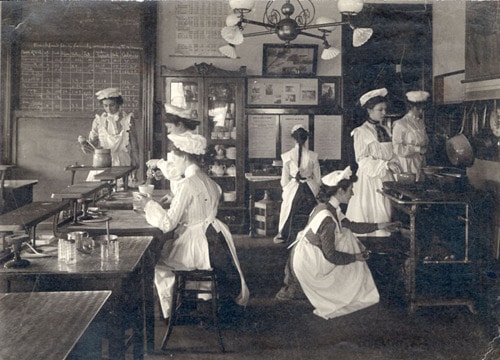
The University of Wisconsin got its own Department of Home Economics in 1903. This image shows students working in one of the department kitchens in the 1910s. To see more images of home economics instruction at UW-Madison, visit the digital collection Home Economics to Human Ecology: A Centennial History at the University of Wisconsin-Madison.
Search for Efficiency
We all want to be more efficient in the kitchen, don’t we? Kitchen efficiency was a major concern of the national home economics movement. Their efforts led to smaller kitchens, space-saving cabinetry, and countless time and motion studies to map every movement involved in meal preparation. Home economists gave us the “work triangle,” which specified where each cabinet and appliance should be to maximize production and minimize time. It’s an idea still in use today.
In 1958, University of Wisconsin home economist May Cowles calculated the time and walking distance saved using a more efficient, “synthesized” kitchen for the Journal of Home Economics.
Before Dear Abby, There Was Dear Nellie
Nellie Kedzie Jones was a nationally recognized pioneer in home economics who brought down-to-earth and good-humored advice to rural farm women through her columns in The Country Gentleman from 1912 to 1918. Jones knew of what she spoke – she and her husband ran a farm in Marathon County, Wisconsin.
Jones wrote a particularly vivid series of advice columns in the form of letters to an imaginary young niece named Janet from her “Aunt Nellie.” Young Janet, with her husband Ben, had supposedly just moved to an old farmhouse from the city and desperately needed advice on how to handle the overwhelming work burden. Jones’s basic message was that a farm wife must be efficient and spare herself in any small ways she could so that she did not change into an overworked piece of farm equipment.
Homemaking on the Air
Six mornings a week, starting promptly at 10am, home economist Aline Hazard greeted women across Wisconsin on WHA Radio’s Homemakers’ Program. Hazard, a University of Wisconsin home economist, and her colleagues instructed the unprepared homemaker on how to pickle, prepare frozen food, select a washing machine, and countless other household tasks. Hazard hosted the program for three decades, from 1933 to 1965, and was one of the most recognizable voices in the state.
Sometimes Hazard took her show on the road, broadcasting live from beautiful gardens and other places of interest to Wisconsin women. This photo (below) is from a 1940s broadcast.
Read more about Hazard and the Homemakers’ Program in Erika Janik’s article “Good Morning Homemakers!” in the Wisconsin Magazine of History 90:1 (2006).
Home Economics as a Natural Vocation
Milwaukee-Downer College was a women’s college founded in 1895 after the merger of two older women’s colleges. In 1901, the school’s home economics department was created, though the program was initially intended for personal enrichment rather than as a career path. The school’s president, Ellen Sabin, saw the domestic sciences as a woman’s chief vocation and one for which she possessed the unique qualifications to understand.
The above photo shows the junior majors of the Department of Home Economics at Milwaukee-Downer in 1922. According to the image caption provided by Lawrence University, these women were also known as the “Carefree Thirteen.” Milwaukee-Downer College was consolidated with Lawrence University in Appleton in 1964. To find out more about the history of Milwaukee-Downer College, see Lynne H. Kleinman, The Milwaukee-Downer Woman (1997).
Sources
The images in this post come from the following digital collections. Click the links to browse the full collections.
- Home Economics to Human Ecology: A Centennial History at the University of Wisconsin-Madison, University of Wisconsin Digital Collections
- Lawrence University Archives Digital Collections
- Turning Points in Wisconsin History, Wisconsin Historical Society
- UW-Madison Collection, UW-Madison Archives by way University of Wisconsin Digital Collections


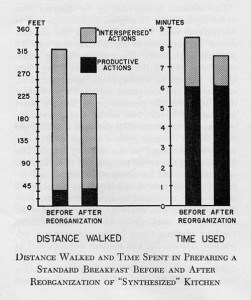
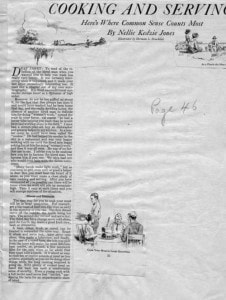
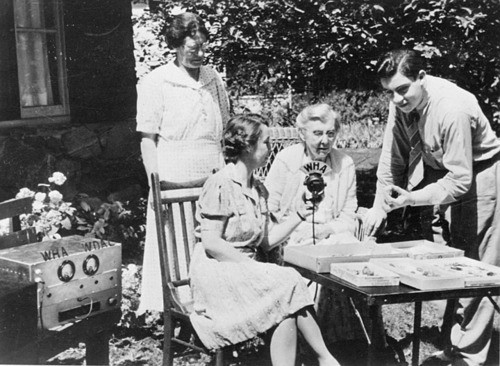
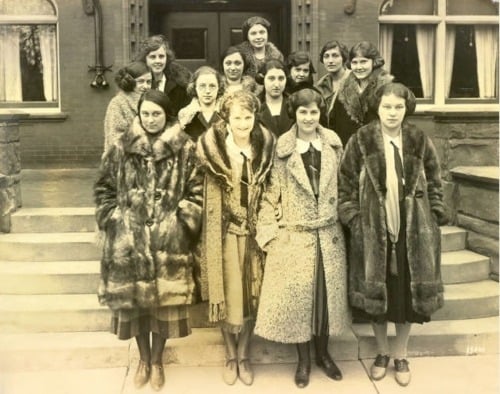


You must be logged in to post a comment.